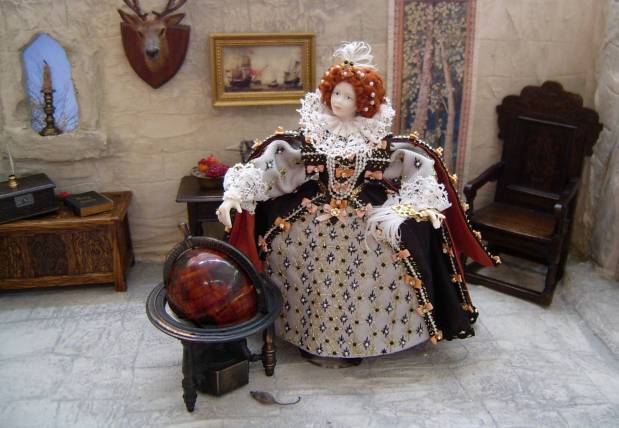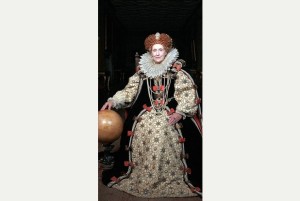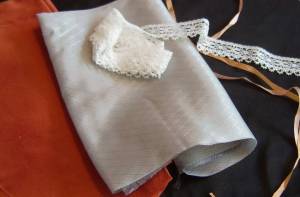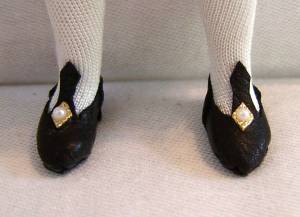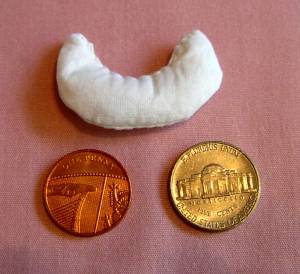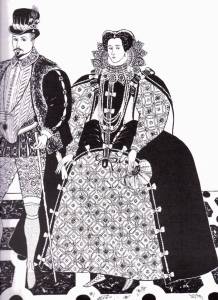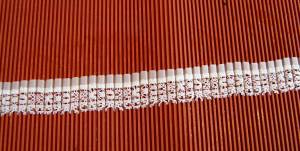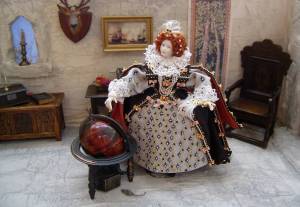THE MAKING OF ARMADA QUEEN ELIZABETH 1ST.
Queen Elizabeth 1st has long been my most favourite of the English monarchs, and her mother Anne Boleyn, my favourite of King Henry VIII’s wives.
Having seen a BBC docu-drama all about the Spanish Armada, with the wonderful Anita Dobson as an elderly Queen Elizabeth 1st, I felt a familiar urge grab me……anyone with an ‘artistic temperament’ will understand what I mean!
At the end of the TV program, Anita/Elizabeth appeared in this most marvellous costume, based on the one depicted in the portrait above, that the real Queen Elizabeth commissioned after her victory over the Spanish King. This has always been one of my most favourite costumes….to look at. But now….suddenly……I had the urge…the urge that cannot be ignored……I HAD to make it… in miniature.
Sometimes, I feel I need a challenge, something that will really push me, and this, I decided, was going to be it. Costume books were consulted, fabric stash was raided and more fabric, ribbon and lace ordered, plus a good stock up on mini faux pearls (and a lot were needed!) and other gems. The boxes of body parts came out (sounds dreadful I know, but that’s exactly how it works when you make dolls!) and suitable parts selected for the actual doll.
Then and only then, could the urge be purged!
Since Queen Elizabeth 1st was known for wearing white lead make-up, I chose body parts cast in a beautiful translucent white porcelain, normally used for ghosts (oh yes….I do make ghosts too, both headless and with head, after all, every dollshouse needs a ghost!).
The doll was then bodied, ready to start dressing and I also made the wig. Bearing in mind the skirt of this costume is quite wide, I made the wig on the wide side too, in order to balance the doll, top and bottom.
With the final choice of fabric and trims etc gathered together in one place (no mean feat in my house…..oh how I long for a proper workroom with storage!), it was time to make a start. I decided I would make all the pattern pieces as I went along so that I could get on with my favourite part….the dressing.
First to be applied was Elizabeth’s stockings, pure silk of course. As with all my miniature dolls, she had to have the lace-trimmed drawers to hide the join between the lower porcelain leg and the upper soft wired thigh and lower torso.
I liked the shape of some Elizabethan men’s shoes I’d seen in a costume book so, since women’s shoes were similar to those worn by men, I based my Elizabeth’s real leather slippers on these and added a little ‘bling’.
Then I added a short length underskirt (which on a real human woman would have been a full shift). Over this and worn very low down on the hips, is a (modified for a miniature doll) farthingale (skirt support).
This in turn is supported underneath by a hip pad or ‘bum roll’. You can’t see this in the picture because it is worn at the back. This also helps to tilt the farthingale slightly up at the back and forwards, as was the fashion then, so I have included a separate picture so you can see what it looks like. It is basically just a crescent shaped pad.
Next to tackle was the ornate petticoat. On a miniature doll this is usually made as a centre front panel only, to avoid adding unnecessary bulk to such a small frame. The silvery grey silk I had chosen has a lovely diamond pattern woven into it, so I embroidered the gold and black star shapes into these, which worked quite well. It took a very long time to complete both the front panel and the matching sleeves, but was well worth the effort. Once the panel was in place on the doll, it was time to make the black silk over skirt.
During the costume research process, it became clear to me that during the late 1580s, the shape of the gown skirt in particular was quite different to that of the 1570’s and 1590’s. The opening at the front was held out over the richly decorated petticoat in a wide but very definite curve. You can see this clearly in the fashion plate below.
It took a while to work out exactly how to do this in miniature but I got there in the end.
The bodice was quite straightforward and so were the main sleeves with their lace cuffs. The long hanging false sleeves were also something that I had tackled before. It was difficult to see from the painting what they were lined with so I chose a darker shade of coral silk to tone with all the tiny coral pink bows. Once the two sets of sleeves were in place, I made the sleeve rolls but did not pad them (they would have been padded for a real human) as this would have added too much bulk to the doll. The last piece of the bodice was the elongated stomacher at the centre front.
Next to prepare was the wide lace and silk ruff which had to be pleated on the board.
Whilst this was drying, I set about making all the tiny silk bows from 4mm silk ribbon in shades of coral and dark coral which was a very popular colour at that time. I secured some of these to the middle of the stomacher before adding strings of tiny faux pearl beads.
Once all this decoration was in place I was finally able to attach the lace ruff, along with the wig which I decorated with yet more pearls. It was not really very clear from the painting what exactly Elizabeth was actually wearing on her head, so I decided to use a golden feathered ornament.
The very last part of the costume was completed with a little golden filigree feather fan, again using pearls as decoration.
You may have noticed that at the end of the bodice stomacher, there is a pale pink bow with jewelled centre and a drop pearl. (I had originally forgotten to add this pearl but have now done so!)
This holds an enormous amount of symbolic significance. The bow and pearl are placed in the area of the body where, if Elizabeth had been a King, the codpiece would have been worn to symbolise the King’s masculinity.
The pink bow makes a huge statement to the other (male) rulers of that time, especially to the King of Spain! Elizabeth’s statement to the world is saying ‘Look at me. I am as powerful and victorious as any King, but first and foremost I am a woman….and proud of it’.
The placing of the drop pearl symbolises the womb and denotes purity….she is the Virgin Queen and therefore not ruled or owned by any man. This is symbolically repeated all over the costume with the sheer amount of pearls….she is dripping in pearls….therefore she is telling the world that she is pure.
It is worth noting the sheer embarrassment, both political and personal that was caused to the King of Spain by this English victory. The Spanish ships were much bigger and far outnumbered the English. Spain by comparison was a much larger and more powerful country than England. King Philip of Spain had once technically been King of England when he was married to Elizabeth’s older sister Mary. He had also asked for Elizabeth’s hand in marriage when she was younger and she was being pressurised into looking for a husband…but she had refused him. Elizabeth was also Protestant, something that was not very popular for a monarch in Europe at that time.
Basically, little tiny England with its mere female ruler had fought off the might of Spain and had ‘singed the King of Spain’s beard.’ In our 21st century language, Philip had been beaten by a girl……the girl that nobody ever thought would be Queen…..the girl that was Queen of England for over 40 years…. and the girl whose reign became known as England’s ‘Golden Age’.
